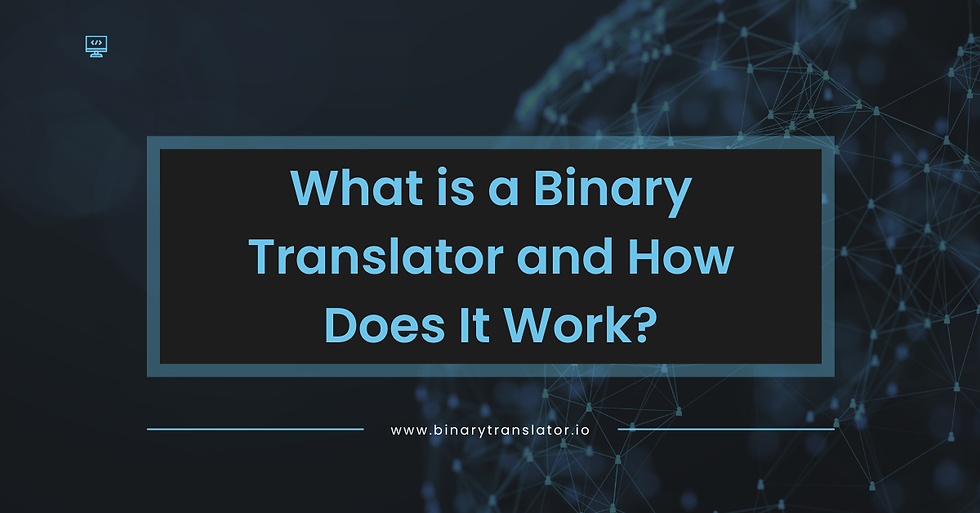What is a Binary Translator and How Does It Work?
- support250383
- Aug 29, 2024
- 3 min read

In our regular daily existences, we connect with PCs, cell phones, and different other computerized gadgets. However, have you ever considered how these devices interpret and process the data we provide? The response lies in a major language known as twofold code. The majority of people, on the other hand, may have trouble comprehending binary code. This is where a paired interpreter becomes possibly the most important factor. We'll look at what a binary translator is, how it works, and why it's so important in the digital world in this article.
Understanding Binary Code
Before getting into the specifics of what a binary translator is, it's important to know how binary code works. Binary uses only two digits because it is a base-2 number system: 0 and 1. These digits are known as "bits." Binary is ultimately used to represent every piece of data in a computer, including text, images, and sounds. For instance, the letter "A" in paired code is 01000001.
Binary code is used by computers due to its simplicity and dependability. Binary is the most efficient programming language for computers because its two states, 0 and 1, can easily represent the off and on states of a computer's electrical components.
A binary translator: what is it?
A twofold interpreter is an instrument or programming that changes over paired code into comprehensible text or the other way around. A binary translator, for instance, would be used to decode a string of binary code if you wanted to understand its meaning in plain English. A binary translator, on the other hand, is able to translate text into binary code as well.
Whether you're a student learning about computer science, a developer working on a project, or just curious about how binary code works, binary translators are incredibly helpful.
What is the Operation of a Binary Translator?
Surprisingly simple is the process of converting binary code into text or text into binary code. The process is as follows:
Conversion from Binary to Text:
The binary translator first divides the binary string into eight groups of bits, or "bytes," before converting it to text. Every byte relates to a particular person in the ASCII (American Standard Code for Data Trade) table.
For instance, the ASCII table's letter "A" is represented by the binary string 01000001. The double interpreter looks into this twofold string in the ASCII table and results the relating letter.
This procedure is repeated for each eight-bit group in the binary string, eventually transforming the string as a whole into text that can be read.
Conversion from Binary to Text:
The binary translator reverses the process of converting text to binary. It searches the ASCII table for the binary value of each character in the text.
For instance, the ASCII character "A" has a value of 65, which in binary is 01000001. After converting the letter "A" into its binary equivalent, the binary translator moves on to the subsequent text character.
This procedure continues until all of the text has been transformed into binary code.
What's the Use of a Binary Translator?
Anyone working with computer programming, data encryption, or digital communications needs a binary translator. Binary translators are crucial for the following reasons:
Learning Apparatus:
Understanding binary code is essential for computer science beginners and students. By letting users see how text and binary relate to one another, a binary translator makes it easier for people to understand how binary works.
Development and troubleshooting:
Developers frequently work with binary-formatted low-level data. A parallel interpreter assists them with rapidly changing over this information into a more justifiable structure, making troubleshooting and improvement more effective.
Security and encryption of data:
Data is frequently encrypted with binary code in cybersecurity. Understanding and interpreting this parallel code is indispensable for guaranteeing that information is communicated safely and that unapproved parties can only with significant effort unravel it.
Exploration and Curiousness:
A binary translator is a hands-on way to learn about the world of binary code and the fundamental computer language for people who just want to know how computers work.
Where Can I Locate a Trustworthy Binary Translator?
There are numerous online tools for using a binary translator if you are interested. Binary Translator is one such user-friendly and dependable tool. This online tool is a useful resource for anyone working with or learning about binary code because it makes it simple to convert text to binary and vice versa.
Conclusion
All in all, a double interpreter is an integral asset that overcomes any barrier between human language and the twofold language of PCs. Understanding and using a binary translator can greatly enhance your digital world knowledge and capabilities, whether you're a student, a developer, or just curious about computers. A binary translator makes the complicated world of binary code accessible to everyone by converting binary code to text and text to binary code.



Comments